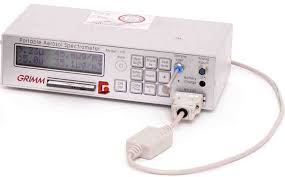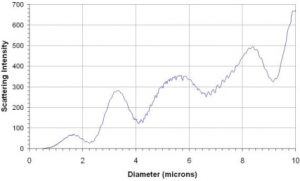Instrument Support Level 2
Grimm Aerosol Technik, Dust Monitor 1.108
ncas-opc-1
aerosol-size-distribution
£15,000
24 cm × 24 cm × 6 cm. 2.4 kg
See page for details
£20
Calendar

GRIMM Optical Particle Counter 1.108
GRIMM has been manufacturing OPCs for many years, and they have a reputation for producing reliable instruments for long term monitoring. The unit is mains powered, but also comes complete with a battery. The unit is completely controllable from the front panel, although data logging is normally done via a PC.
This instrument measures the size-resolved number concentration per cubic centimetre of particles in the size range of 0.3 to 20 microns (optical). By summing up the total number of overall sizes, the total number concentration can be derived. The unit also has several audible alarms when operational parameters are exceeded.
OPCs have a very basic design principle: particles are sampled into the instrument and traverse perpendicular to a laser beam.
A detector set off-axis from the laser and particle beam then records scattering intensity signals from individual particles. These are then processed to give a total number concentration and a size-number distribution.
The intensity of the scattered light is a function of the particle size, shape and refractive index, which in most OPCs is assumed to have 0 absorbing (imaginary) components. If absorbing aerosol are sampled, some of the light will be absorbed, so the recorded scattered intensity is less, so the instrument will undersize the particle.
Contact the AMOF instrument scientists for details on how this might affect your application.
In 1908, Mie developed a theory for calculating the relationship between particle size and scattering intensity, a theory that now bears his name. Mie theory is extremely complex and requires knowledge of the particle refractive index and the wavelength of the light source.

The plot above shows the relationship between scattering intensity and diameter for a given wavelength and scattering angle. As can be seen, a simple relationship does not exist. However, the ambiguities in the Mie curve can be improved with sophisticated optical design.
The instrument is serviced annually by the manufacturer if the instrument has been used extensively. This includes checking the flow rate, optics alignment and replacing filters and tubing
It should be noted that there is no absolute calibration standard for particle number concentration. The sizing and counting efficiency is checked using PSL spheres and a reference counter.
A basic service check will be performed on the unit before it is shipped to the user.
Consumables
Tubing to connect the OPC to a sampling system or environment will not be provided. The OPC takes a 4mm OD tube (push-fit connector).
Costs
- Instrument Insurance
- This system must be insured by the user for £15K and covers loss, theft or damage to the instrument: damage is that over and above general wear and tear. The system has been designed to be rugged and autonomous. Even so, the end-user must respect the fact that the system is a precision optical instrument that must be treated with great care.
- The user is responsible for the instrument from the time it leaves the AMF to the time it is returned and signed off as in an acceptable operating condition by the IS: this will be done as soon as is possible on its return.
- Public Liability Insurance
- The AMOF is not liable for any damage or injury arising from the deployment or operation of this instrument when unattended by the IS.
- Shipping Expenses
- The user is liable for all costs arising from the shipping of the instrument both to and from a deployment.
- IS T&S
- The user is responsible for coving the travel and subsistence expenses of the IS while attending the instrument.
Shipping
Please contact the IS for details nearer the time of shipping. If exact weights and dimensions are required, these can be arranged with the IS.
The instrument needs to be housed in a dry environment that does not exceed the environmental conditions as detailed in the specifications. The instrument can be mounted in any orientation. It is possible to house the outdoors. Please contact the IS for further details.
Eye safety
- This instrument is a class 1 laser-based instrument and is eye-safe for all conditions of use, providing the covers are not removed.
Electric safety
- Under no circumstances should any attempt be made to open up the main body of the instrument. This will expose the user to high voltages. Only appropriately qualified persons should attempt to fault find these units.
Attended operation
- There is no requirement for the system to be attended during operation from a safety standpoint.
When unpacked the instrument has the following physical specification
Particle Size Range
- 0.3 to 20 μm optical size (15 channels)
Maximum Particle Concentration
- 2000 counts per cm3 or 0.1mg per cm3
Sensitivity
- 1e-3 particles per cm3 (or 1 particle per litre)
Sampling Time
- 1 data stream per 6 second. Additional average data file can be generated (user selectable)
Flow Rates
- Aerosol sample: 1.2 lpm
Reproducibility
- +/- 2%
Operating Temperature
- +4 to 45°C
Operating Humidity
- 10 to 90% RH non-condensing
Power
- 220 VAC, 50–60 Hz
Communications
- RS232 (9-pin), null modem
Dimensions (LWH)
- 240 mm × 240 mm × 60 mm
Weight
- 2.4 kg
This instrument measures the size-resolved number concentration per cubic centimetre of particles in the size range of 0.3 to 20 microns (optical). The instruments produces a data string once per 6 seconds.
Field Data
- The instrument produces a range of out files and all are text format.
- The user can download (but not delete) this data from the instrument but it should be noted that this data will not have been quality controlled.

Archive Data
- Data is provided in NetCDF files following the AMOF data standard
- Files contain no more than 24hr of data.
- Instrument name is
- ncas-opc-1
- The data product(s) associated with this instrument:
- Example data file
